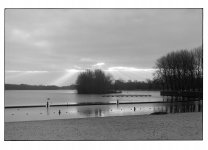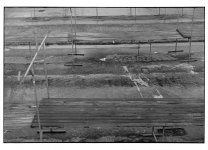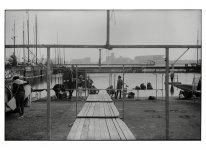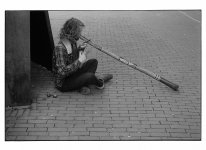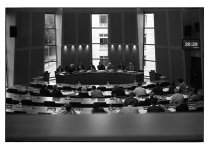p.giannakis
Pan Giannakis
Even someone like me, who i am not into footbal, i know Van Basten. Ajax is a well know team in greece - the name Ajax has helped i think (a hero of Trojan war).This is the world famous Dutch soccer player Marco van Basten, three-time European Footballer of the Year and two-time World Footballer of the Year, is recognised worldwide as one of the best footballers of all time. The former striker was praised for his ball stability, technique, tactical class and way of finishing. During his active career as a player, he mainly caused a furore at Ajax and AC Milan. In Amsterdam service, the striker won three national titles and the European Cup Winners Cup. Here in disguise in a raincoat on a ladies bike.
gelatin silver print (elmar 50mm f3.5 uncated) leica lll
Erik.
View attachment 4815678
Very nice picture, well captured as always.
Erik van Straten
Mentor
Thank you, Brusby! I always use the same stuff: Tmax400 film, Ilford Perceptol developer (1+3, 10 minutes @ 20 degrees C). Printed on Ilford MG fiberbase glossy, developer Tetenal Eukobrom, enlarger Leitz Focomat llc, print dryer 1950's Büscher 50 x 60 cm with digital heat control, pressed on a Seal Compress 110 and scanned with an Epson 600.I've seen those. I guess ya just gotta have a compliant subject who will hold still while you're measuring. Anyway, nice job. Tones look good too. What film and chemistry were you using?
Erik.
Last edited:
Erik van Straten
Mentor
Thank you, Pan, (alas focus in the shot is not for 100% correct).Even someone like me, who i am not into footbal, i know Van Basten. Ajax is a well know team in greece - the name Ajax has helped i think (a hero of Trojan war).
Very nice picture, well captured as always.
Erik.
Last edited:
Andrew Sowerby
Well-known
Great photos as always Erik. Thanks for sharing.
giulio stucchi
Well-known
I´m not really a huge football fan but I grew up a stone away from "San Siro - Stadio Meazza" in Milan and back in the 90s we were allowed to enter the stadium to watch the last 10-15 minutes of a match (impossible and unthinkable nowadays) and I joined some friends from time to time to see the magic trio of Van Basten, Gullit and Rijkaard.
Hope is all good with you Erik, I´ll try to come back and post more regularly in here.
Best
Giulio
HuubL
hunter-gatherer
Absolutely great shots Erik! I'm not frequenting here, but each time I visit RFF, I look you up to admire and enjoy your photos with your classic camera gear.
brusby
Well-known
Thank you, Erik. Good skin tones.Thank you, Brusby! I always use the same stuff: Tmax400 film, Ilford Perceptol developer (1+3, 10 minutes @ 20 degrees C). Printed on Ilford MG fiberbase glossy, developer Tetenal Eukobrom, enlarger Leitz Focomat llc, print dryer 1950's Büscher 50 x 60 cm with digital heat control, pressed on a Seal Compress 110 and scanned with an Epson 600.
Erik.
JMF
Established
Lovely shots Erik !
Best, JM
Best, JM
Erik van Straten
Mentor
I always use Tmax400 devoped in Perceptol. I print the negatives with a Leitz Focomat IIc on Ilford multigrade fiber base glossy and dry the prints on a Büscher 50x60 cm (from the 1950's) equipped with a modern digital temperature control device. The prints are flattened on a Seal Compress 110, scanned on an Epson V600 Photo and edited with a modern version of Photoshop Elements 2.0.I've seen those. I guess ya just gotta have a compliant subject who will hold still while you're measuring. Anyway, nice job. Tones look good too. What film and chemistry were you using?
The William Shatner lookalike on the picture above is a woman, btw.
Erik.
Last edited:
Erik van Straten
Mentor
Erik van Straten
Mentor
Erik van Straten
Mentor
Erik van Straten
Mentor
Bingley
Mentor
Ha!! Interesting, Erik, on the Perceptol dilution. I recall reading a post of yours, a number of years ago, in which you stated you were using Perceptol at a 1+2 dilution, developing for 10 mins. at 20C. Because I loved the tonality of your photos, and was also using TMax 400, I started using the 1:2 dilution and got some really nice results. Turns out this may have been a typo, if you’ve always been using the 1+3 dilution. For example, these two photos were both processed using Perceptol at the 1+2, as opposed to the 1+3, dilution:Thank you, Brusby! I always use the same stuff: Tmax400 film, Ilford Perceptol developer (1+3, 10 minutes @ 20 degrees C). Printed on Ilford MG fiberbase glossy, developer Tetenal Eukobrom, enlarger Leitz Focomat llc, print dryer 1950's Büscher 50 x 60 cm with digital heat control, pressed on a Seal Compress 110 and scanned with an Epson 600.
Erik.
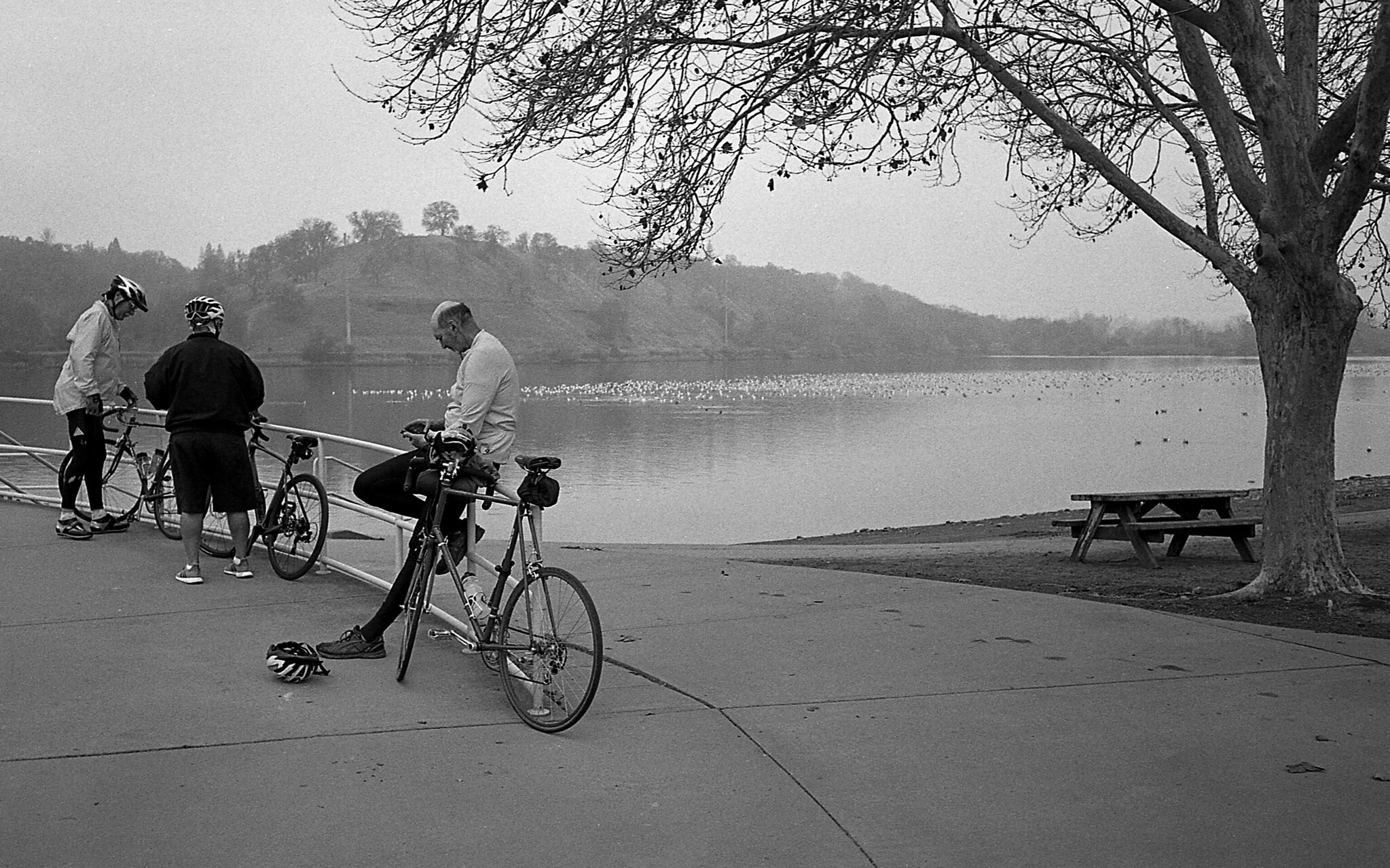 The Riders by Steve Macfarlane, on Flickr
The Riders by Steve Macfarlane, on Flickr Golden State in the Time of Covid by Steve Macfarlane, on Flickr
Golden State in the Time of Covid by Steve Macfarlane, on FlickrSorry for going off-topic. Neither of these photos were taken with an early Elmar lens. But in view of the discussion about your beautiful black and white photographs, it’s interesting to me that there may be a little more flexibility with Perceptol than I’d thought.
Last edited:
Erik van Straten
Mentor
Ha!! Interesting, Erik, on the Perceptol dilution. I recall reading a post of yours, a number of years ago, in which you stated you were using Perceptol at a 1+2 dilution, developing for 10 mins. at 20C. Because I loved the tonality of your photos, and was also using TMax 400, I started using the 1:2 dilution and got some really nice results. Turns out this may have been a typo, if you’ve always been using the 1+3 dilution. For example, these two photos were both processed using Perceptol at the 1+2, as opposed to the 1+3, dilution:
The Riders by Steve Macfarlane, on Flickr
Golden State in the Time of Covid by Steve Macfarlane, on Flickr
Sorry for going off-topic. Neither of these photos were taken with an early Elmar lens. But in view of the discussion about your beautiful black and white photographs, it’s interesting to me that there may be a little more flexibility with Perceptol than I’d thought.
Yes Steve, you are right, I made a mistake, it must be Perceptol 1+2! Thank you for your attentiveness. I love your shots here, above all the cyclists, but the other one is superb too. Would be nice if there was a thread about developers for b+w films. Maybe there is, but I find the new RFf a bit chaotic. Can't find a thing.
Erik.
Last edited:
Erik van Straten
Mentor
mcfingon
Western Australia
Great pictures from the old Elmars here. My Elmar 50/3.5 is a 1935 model, here on my 1933 Leica III.
John Mc

John Mc

Dralowid
Michael
Interesting thread.
Am I right in thinking that there is no dead white in Erik's and Bingley's pictures? By that I mean that even the highlights have some hint of grey (ie a very small percentage of black) in them? Erik's meeting room picture may be an exception.
Am I right in thinking that there is no dead white in Erik's and Bingley's pictures? By that I mean that even the highlights have some hint of grey (ie a very small percentage of black) in them? Erik's meeting room picture may be an exception.
Erik van Straten
Mentor
Yes, sometimes - quite often - the effect of a picture is better when there is no "pure" white to be seen. There are many paintings too without 100% white in them - many paintings by Titian, Raphael and Ingres for instance - and that is not because the paintings are old. There are impressionist paintings too - that represent fog for instance - without any white in them. It is an absurd rule that there should be pure white in a photograph. Too pale pieces in a photo are often disturbing. That's why many photographers burn them through. There are no rules for 100 % white or 100% black in a photograph. Every photographer knows this.Interesting thread.
Am I right in thinking that there is no dead white in Erik's and Bingley's pictures? By that I mean that even the highlights have some hint of grey (ie a very small percentage of black) in them? Erik's meeting room picture may be an exception.
Erik.
Dralowid
Michael
Yes, this is how I understand it. I cringe when I see a painter putting a blob of titanium white on a highlight, it jumps out as if alien...
Share:
-
This site uses cookies to help personalise content, tailor your experience and to keep you logged in if you register.
By continuing to use this site, you are consenting to our use of cookies.


